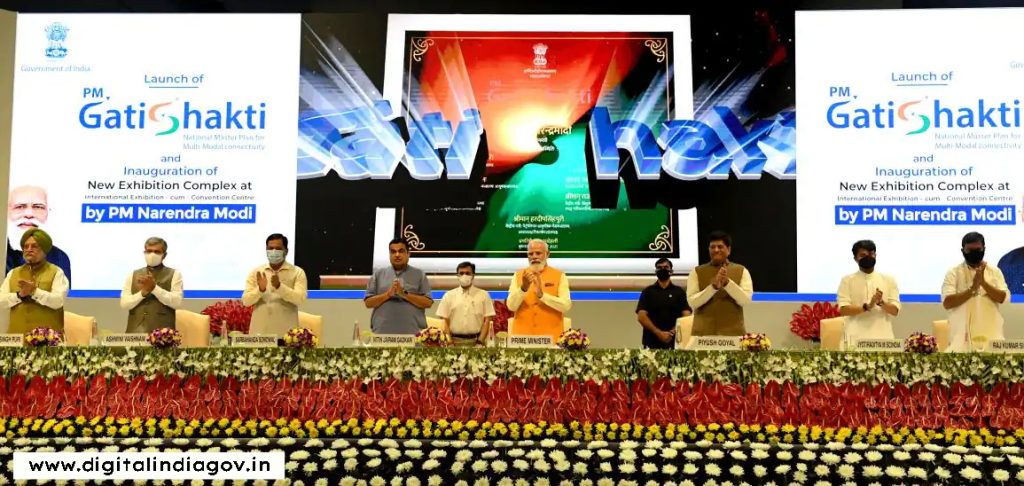PM Gati Shakti Scheme:- In October 2021, Prime Minister Narendra Modi unveiled the National Master Plan for Multi-modal Connectivity or Gati Shakti. The government has unveiled the PM Gati Shakti plan, a daring move to improve India’s infrastructure. The Hindi phrase “gati shakti,” which means “motion power,” describes the vigor and drive behind this creative project. The initiative is expected to completely transform how infrastructure projects are organized, carried out, and planned across the nation. It is an online platform that brings together sixteen ministries covering important industries such as roads, trains, and more to promote coordinated planning and smooth implementation of infrastructure connection projects.
Contents
PM Gati Shakti Scheme
In order to lower logistics costs, the Gati Shakti is a national master plan that aims to coordinate the design and implementation of infrastructure projects in India.
- Gati Shakti is a digital platform that would unite 16 Indian government ministries and departments, including the roads and railways divisions.
- The idea is to coordinate the implementation of infrastructure connectivity projects across the country.
- This initiative, which aims to construct “holistic infrastructure,” is worth Rs. 100 lakh crore.
- This plan will include the current infrastructure projects run by different ministries, including as inland waterways, Sagarmala, Bharatmala, and the UDAN initiative.
- The master plan will also encompass economic zones such as agri-zones, electronic parks, defense corridors, industrial corridors, pharmaceutical clusters, textile clusters, and fisheries clusters.
- There will also be extensive use of technology, including tools for spatial planning created by BiSAG that make use of ISRO pictures.
- The master plan will bring about smooth transportation of people and goods throughout India.
- PM GatiShakti will inform the public and business community about upcoming connectivity projects, other commercial hubs, industrial locations, and the surrounding environment.
- Future economic zones are another idea that Gati Shakti brings up.
- The National Infrastructure Pipeline (NIP) projects, which have a combined budget of ₹111 lakh crore, were the main focus of the program when it was first launched.

Also Read:- YSR Bheema Scheme, Digitize India, Digitize India Platform, Work From Home Jobs, Celebrity Phone Number
PM Gati Shakti Significance
Improving coordination across the many ministries and departments is the program’s main goal. India has endured decades of inadequate infrastructure. The realm of infrastructure building was inherently flawed in various ways.
- There was a lack of cooperation between the various departments. When a road was constructed, for example, it was dug up again by other organizations for the installation of subterranean cables and gas pipelines).
- This was a wasted expense in addition to being quite inconvenient.
- Collaboration between all stakeholders will ensure a last-mile link.
- Project delays resulted from individual ministries and departments sometimes operating in silos, which caused inadequate planning and implementation. Here is where the Gati Shakti program seeks to effectuate a constructive shift.
- With 200+ layers of analytical tools and GIS-based spatial planning, the digital plan will give the executing agency improved visibility by bringing all the data together in one location.
- Given that all of the information is now accessible on the portal via satellite imagery, Gati Shakti will assist ministries and departments in better planning cross-sectoral projects, monitoring their implementation, reviewing their progress, and making required course corrections.
- India’s present high logistics costs of over 13% of GDP make it imperative to lower them in order to maintain the competitiveness of Indian exports in international markets. In order to cut the enormous costs associated with logistics, Gati Shakti plans to bridge the gap between macro planning and local implementation.
PM Gati Shakti Scheme Expected Outcomes
Gati Shakti wants to make India the global center of business.
- It will support the mapping of both planned and current connection projects.
- Made in India’ stands to benefit immensely from a comprehensive and well-thought-out plan for transport links.
- It should aid in the accomplishment of the government of India’s many goals, including building more than 200 new airports, heliports, and water aerodromes, as well as extending the nation’s highway network to a distance of 2 lakh km.
- increasing the capacity of Indian ports to handle cargo and cutting down on turnaround times will increase trade.
- establishing two defensive corridors and eleven industrial corridors.
- It aims to provide 4G connectivity to every village in the nation.
- The network expansion of gas pipelines is another goal.
Concerns about Gati Shakti
In the post-COVID environment, private demand and investment are lacking. Then, there are systemic obstacles with obtaining environmental permits, litigation, and land acquisition, which contribute to the extremely low project execution rate by international standards.

Also Read:- PMEGP Scheme List 2024
Key Features of PM Gati Shakti
The program promises to change India’s infrastructure scene in a number of ways.
- Using a single, centralized digital platform, PM Gati Shakti integrates several government departments for real-time monitoring and integrated planning. This makes it possible to track and monitor project progress in real-time, which promotes efficient cooperation and quick decision-making.
- Interactions Across Sectors: The platform promotes collaborations between various departments and ministries. By preventing effort overlap and assisting with project prioritization, this partnership maximizes resource allocation.
- Infrastructure Integration: This plan unifies state and ministry-specific infrastructure initiatives. It includes programs like Sagarmala, Bharatmala, inland waterways, and others that lower logistical costs and improve last-mile connectivity.
- Enhanced Visibility: With over 200 layers of information about the infrastructure that is currently in place, PM Gati Shakti integrates a robust geographic data store. This all-encompassing perspective facilitates improved planning and decision-making.
- Group for Project Monitoring: The Department of Promotion of Industry and Internal Trade (DPIIT) will assign a specialized crew to monitor the real-time progress of major projects. Interministerial problems will be found and fixed by them, guaranteeing more efficient execution.
Targets Under the PM Gati Shakti Scheme
PM Gati Shakti has set lofty goals for a number of industries that must be accomplished by 2024–2025. Among the noteworthy objectives are:
- Creation of two new defense corridors (in Tamil Nadu and Uttar Pradesh) and eleven industrial corridors with the goal of reaching a defense manufacturing turnover of 1.7 lakh crore.
- Creation of over 38 clusters dedicated to the manufacturing of electronics.
- 109 pharma clusters have been established to increase pharmaceutical production.
- The enlargement of Indian ports to accommodate 1759 MTPA (million tonnes per year) of cargo.
- To improve connectivity, more than 200 new airports, helipads, and water aerodromes have been added.
- Bringing 4G internet to every town, closing the gap in digital access.
- Extending the network of gas pipelines by 17,000 kilometers to guarantee effective energy distribution.
Six Pillars of PM Gati Shakti
Six fundamental pillars form the basis of PM Gati Shakti:
- Comprehensiveness: All planned and ongoing efforts across ministries and departments are fully integrated into the strategy. This guarantees a holistic perspective and encourages effective project management.
- Prioritization: Interactions between departments across sectors enable various departments to successfully prioritize their projects. This cooperative strategy expedites implementation and maximizes resource allocation.
- Optimization: Ministries can identify important gaps and plan initiatives accordingly with the help of the National Master Plan. It assists in choosing the fastest and least expensive routes for the transportation of products.
- Synchronization: By coordinating actions across departments and levels of government, the plan tackles the problem of fragmented efforts. This comprehensive coordination reduces waiting times and boosts productivity.
- Analytical: The scheme provides executing agencies with improved visibility and well-informed decision-making through the use of GIS-based spatial planning and analytical tools that give more than 200 layers of data.
- Dynamic Approach: Using the GIS platform, ministries and departments can obtain up-to-date information on cross-sectoral projects. Accurate progress tracking and intervention identification are ensured by frequent updates and satellite imagery.

Also Read:- Agneepath Scheme Apply
Need for PM Gati Shakti Scheme
The PM Gati Shakti initiative is essential for the following reasons:
- Collaboration Gap: By encouraging advanced information sharing and collaboration across departments that frequently operate independently, the strategy closes the gap between macro planning and micro implementation.
- Logistics Efficiency: Export competitiveness is greatly impacted by India’s logistics expenses, which are estimated to account for 13–14% of GDP. With his emphasis on connectedness and integrated planning, PM Gati Shakti hopes to reduce these expenses and increase exports.
- Economic Growth and Employment: The program promotes sustainable development and fosters the construction of high-quality infrastructure, both of which lead to significant job opportunities and economic growth.
- Partnership with National Monetization Pipeline (NMP): PM Gati Shakti is in line with NMP, offering a monetization framework and drawing capital for the construction of infrastructure.
- Post-Covid Recovery: The plan aims to boost economic development and recovery by addressing the absence of private demand and investment following the COVID-19 pandemic.
- Challenges with Project Implementation: In order to speed up project implementation, PM Gati Shakti seeks to address issues with litigation and delays in land acquisition.
Conclusion
A significant step towards modernizing India’s infrastructure environment is PM Gati Shakti. Through the promotion of coordination, integration, and data-driven decision-making, the plan aims to close current gaps, cut expenses, and quicken development. The country is moving towards a more wealthy and connected future as it adopts this program that looks forward.
FAQ’s
Q. In what ways does PM Gati Shakti tackle the issue of fragmented planning in infrastructure undertakings?
Ans- By uniting 16 ministries on a single digital platform, PM Gati Shakti encourages coordinated planning. This solves the problem of fragmented efforts by guaranteeing real-time coordination, cross-sectoral interactions, and efficient decision-making.
Q. In what ways does the program enhance export competitiveness?
Ans- India’s export competitiveness is impacted by its logistics costs; hence, PM Gati Shakti’s emphasis on integrated planning, last-mile connectivity, and lower logistics costs makes India’s exports more competitive.
Q. In what ways does PM Gati Shakti support the Made in India campaign?
Ans- By creating a thorough transport connection plan that smoothly combines different forms of transit, the program promotes Made in India and creates an atmosphere that is favorable to trade and production.
Suggested Link:- Our Jharkhand
@PAY
